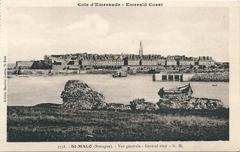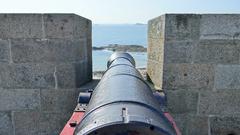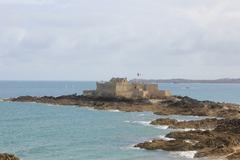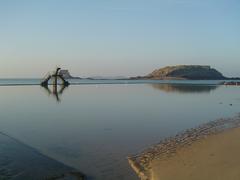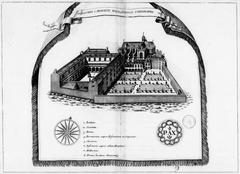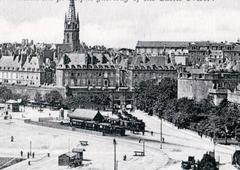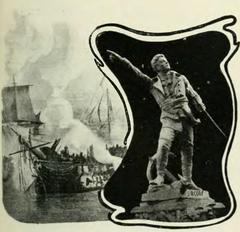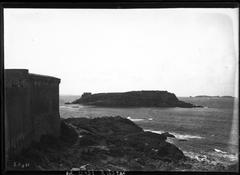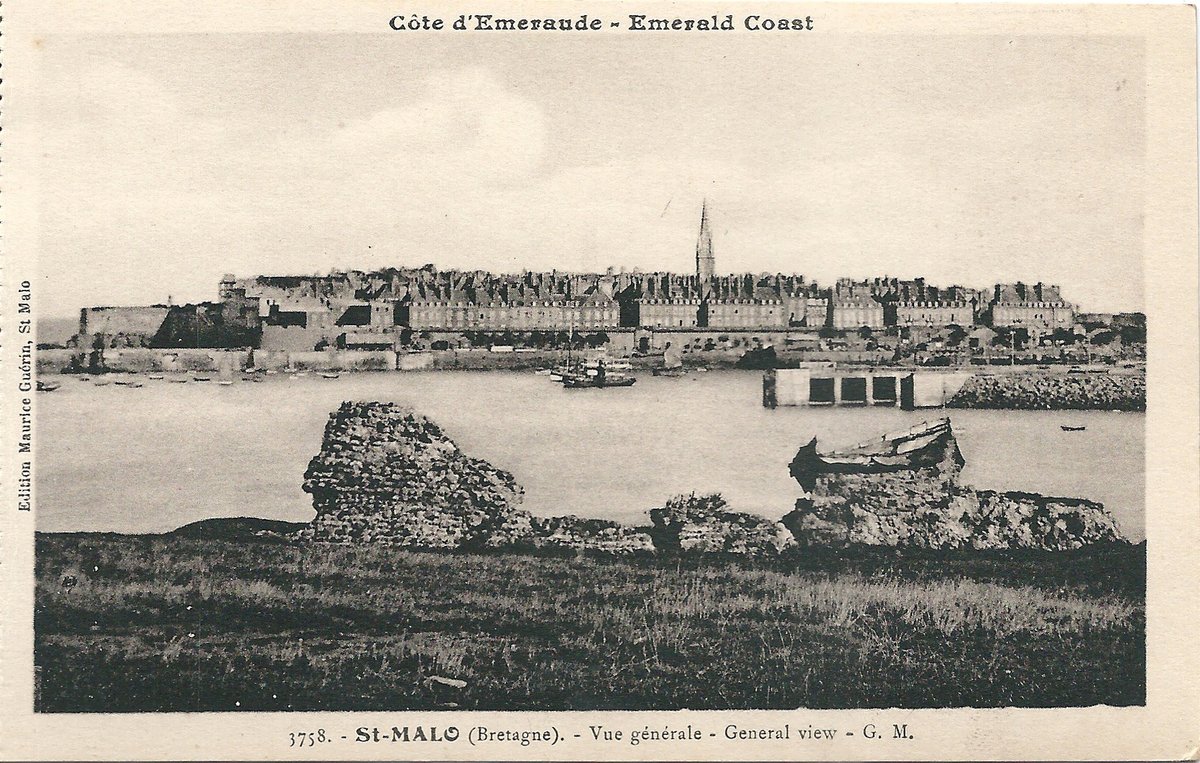
Mur Romain d’Alet: Visiting Hours, Tickets, and Comprehensive Guide to Saint-Malo’s Historical Sites
Date: 14/06/2025
Introduction
Perched on the scenic Cité d’Aleth peninsula in the Saint-Servan district of Saint-Malo, France, the Mur Romain d’Alet is a remarkable monument that traces the rich and layered history of Brittany. Dating from the 1st century BCE through the 4th century CE, this ancient Roman wall exemplifies the region’s strategic importance during the Gallo-Roman era and beyond. The site’s exceptional preservation offers visitors a tangible connection to the past, with remnants spanning from early defensive architecture to medieval and World War II fortifications. Whether you’re passionate about archaeology, military history, or simply seeking panoramic views of Saint-Malo, the Mur Romain d’Alet is an essential stop on your journey (Saint-Malo Tourisme; InfoBretagne).
Table of Contents
- History and Foundations of the Mur Romain d’Alet
- Architectural Highlights and Archaeological Significance
- Medieval and Modern Military Legacy
- Main Attractions and Points of Interest
- Visitor Information: Hours, Tickets, and Accessibility
- Getting There and Practical Travel Tips
- Guided Tours and Events
- Nearby Attractions
- Visitor Experience: Facilities and Recommendations
- Frequently Asked Questions (FAQ)
- Plan Your Visit: Key Takeaways and Call to Action
- References and Further Reading
History and Foundations of the Mur Romain d’Alet
The origins of the Mur Romain d’Alet trace back to the 1st century BCE, when the Celtic Coriosolites established a settlement at the mouth of the Rance River, leveraging its natural defenses and trade potential. Roman conquest in 56 BCE transformed Alet into a fortified administrative center. By the 3rd and 4th centuries CE, increased threats from raiders prompted the construction of the robust stone wall using local granite and advanced Roman masonry techniques. The wall’s design included towers and gates, enclosing administrative buildings, public spaces, and early Christian worship sites (Saint-Malo Tourisme; Camping de l’Ile Verte).
The site’s enduring significance is evident in its continuous occupation through the medieval period, when it became a religious center and seat of the bishopric. The remains of the pre-Romanesque Saint-Pierre d’Aleth Cathedral, among the oldest in Brittany, stand as testament to this era.
Architectural Highlights and Archaeological Significance
The Mur Romain d’Alet showcases the durability and sophistication of Roman military engineering. Surviving sections of the wall, some up to 4 meters in height, are constructed with opus caementicium (Roman concrete) faced with granite blocks (Camping de l’Ile Verte). The archaeological park includes remains of a Gallo-Roman basilica, medieval structures, and interpretive panels that illustrate the site’s transformation over time.
The wall’s strategic placement on a promontory offers commanding views of the Rance estuary and Saint-Malo bay, underlining its defensive purpose and contributing to the site’s continuing appeal for visitors (Outquest).
Medieval and Modern Military Legacy
Following the relocation of the bishopric to Saint-Malo Intra-Muros in the 12th century, Alet’s prominence declined but its defensive function persisted. The site was further fortified in 1759 and again during World War II, when German forces built bunkers and gun emplacements as part of the Atlantic Wall. These fortifications now house the Mémorial 39-45 museum, which documents Saint-Malo’s wartime history (Mémorial 39-45 Museum; St-Malo.com).
Today, the Mur Romain d’Alet is recognized as a protected monument historique, blending Roman, medieval, and modern military architecture in a unique open-air museum (Saint-Malo Tourisme).
Main Attractions and Points of Interest
Roman Wall of Alet
Explore the best-preserved segments of the Roman wall along Rue Saint-Pierre, featuring original towers and gates. Archaeological evidence of a 4th-century basilica and administrative buildings is also visible (carnetsvanille.com).
Saint-Pierre d’Aleth Cathedral Ruins
Discover the remains of the pre-Romanesque cathedral, including the 10th-century apse and traces of older foundations, highlighting Alet’s role as an early Christian center (saintmalowithlove.com).
Fort de la Cité d’Alet
This layered site displays fortifications from the Roman era through WWII, offering panoramic views and insight into the evolution of military defenses (historyalive.je).
Mémorial 39-45 (World War II Memorial)
Located in German-built bunkers, this museum presents artifacts, photographs, and personal accounts from Saint-Malo’s WWII experience. Guided tours are highly recommended (Mémorial 39-45 Museum).
Tour Solidor
A short walk from the wall, this 14th-century tower complex offers historical exhibits and spectacular views of the estuary (petitfute.com).
Panoramic Viewpoints and Trails
Enjoy walking paths around the peninsula, part of the GR34 coastal trail, with benches and spots for photography or picnics (carnetsvanille.com).
Visitor Information: Hours, Tickets, and Accessibility
- Visiting Hours: The outdoor Mur Romain d’Alet site is open year-round from dawn to dusk. The Mémorial 39-45 museum operates from 10:00 AM to 6:00 PM (April–October) and 10:00 AM to 5:00 PM (November–March).
- Tickets: Access to the Roman wall and archaeological park is free. The Mémorial 39-45 museum requires a paid ticket (approximately €5 for adults; discounts for children and seniors).
- Guided Tours: Available during peak tourist seasons and special events. Booking in advance is recommended via the Saint-Malo Tourist Office.
- Accessibility: The site features uneven terrain and some steep, unpaved paths. While alternative routes and resting spots exist, accessibility is limited for visitors with mobility challenges. Contact the tourist office for detailed information.
Getting There and Practical Travel Tips
- Location: About 15–20 minutes on foot from Saint-Malo Intra-Muros; also accessible by local bus to Saint-Servan. Limited parking is available near the peninsula.
- Travel Tips: Wear comfortable shoes for uneven ground. Bring water, sun protection, and a camera for panoramic photos. Early mornings or late afternoons offer optimal lighting and fewer crowds.
- Facilities: No on-site restrooms or cafés; nearby Saint-Servan district offers amenities.
- Weather: Prepare for variable conditions typical of Brittany—pack for wind and rain.
Guided Tours and Events
Seasonal guided tours provide in-depth perspectives on the site’s history and archaeology. Special events, such as historical reenactments and educational workshops, are held throughout the year (Saint-Malo Tourisme). Check the website for schedules and booking information.
Nearby Attractions
- Tour Solidor: Medieval tower with maritime history exhibits.
- Parc des Corbières: Parkland for picnics and nature walks.
- Port des Bas Sablons: Marina with cafés and views.
- Saint-Malo Intra-Muros: Walled city with museums, shops, and beaches (monsieur-de-france.com).
Visitor Experience: Facilities and Recommendations
- Best Time to Visit: Spring through early autumn for pleasant weather and vibrant scenery.
- Site Layout: Open-air, unfenced ruins with interpretive signage in French (some English translations).
- Recommended Duration: 1–2 hours to fully explore the wall, cathedral ruins, museum, and viewpoints.
- Picnicking: Grassy areas and benches available; bring your own supplies.
- Photography: The location is ideal for landscape and architectural photography; drones may require authorization.
Frequently Asked Questions (FAQ)
Q: What are the visiting hours of the Mur Romain d’Alet?
A: The site is open year-round from dawn to dusk; the Mémorial 39-45 museum has seasonal hours.
Q: Is there an admission fee?
A: The outdoor site is free; the museum charges an entrance fee.
Q: Are guided tours available?
A: Yes, seasonally; reserve through the tourist office.
Q: Is the site accessible for wheelchairs or strollers?
A: Accessibility is limited due to uneven terrain. Check with the tourist office for details.
Q: Where are the nearest restrooms and cafés?
A: In the Saint-Servan district, about a 10-minute walk from the site.
Q: Can I bring my dog?
A: Yes, dogs are allowed but must be kept on a leash.
Plan Your Visit: Key Takeaways and Call to Action
The Mur Romain d’Alet stands as a living testament to Saint-Malo’s ancient, medieval, and modern history. Its free access, evocative ruins, and sweeping views make it a highlight for any visitor to Brittany. Pair your visit with nearby attractions like Tour Solidor and the Mémorial 39-45 museum for a comprehensive historical experience.
Enhance your exploration by downloading the Audiala app for guided tours, interactive maps, and the latest event updates. Support heritage preservation by respecting site rules and engaging with local businesses during your stay.
For more information and updates, consult the Saint-Malo Tourist Office or the Mémorial 39-45 Museum.
References and Further Reading
- Saint-Malo Tourisme – Explore the Origins of Saint-Malo at the Cité d’Aleth
- InfoBretagne – Historical Overview of Saint-Malo
- Saint-Malo Tourist Office
- Carnets Vanille – Visiting the Roman Wall of Alet
- Outquest – The Roman Wall of the Cité d’Aleth
- Mémorial 39-45 Museum Official Site
- Camping de l’Ile Verte – La Cité d’Aleth Article
- Audiala Mobile App for Guided Tours
- Navaway – Cité d’Aleth Information
- Historical Article on Mur Romain D’Alet (Persee.fr)
- GoBrittany – Saint-Malo History
- Entre Patrimoine et Nature – St Malo: Aleth, Romains et Chrétiens
- Mapcarta – Mur Romain de la Cité d’Aleth
- Saint-Malo With Love – The City of Aleth
- History Alive – Fort de la Cité d’Alet, St Malo
- Petit Futé – Que faire à Saint-Malo: Les 15 Incontournables
- Portail Aquapages – La Cité d’Aleth
- Monsieur de France – What to See in Saint-Malo
For a seamless and enriching journey through Saint-Malo’s storied past, plan your visit to the Mur Romain d’Alet today. Download the Audiala app for exclusive audio guides and interactive maps. Stay connected with official tourism channels for the latest news and events.
